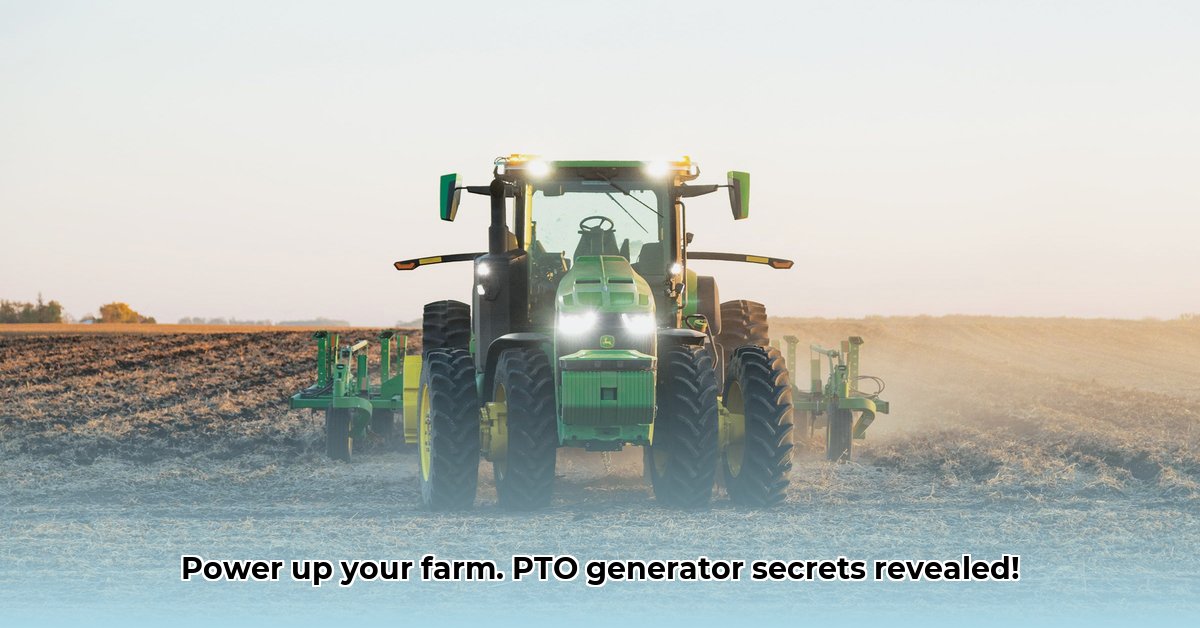
Planning Your PTO Generator Project
Before investing in a PTO (Power Take-Off) generator, meticulously plan your energy needs. This isn't merely about powering a few lights; it's about powering your entire farming operation sustainably. Follow these steps for a successful implementation:
Assess Energy Demand: List every electrical device on your farm and determine its power consumption in kilowatts (kW). Calculate your average daily and peak (highest usage) energy demands. This is crucial for selecting the appropriately sized generator. (Note: Overestimating is better than underestimating.)
Evaluate Tractor Compatibility: Check your tractor's PTO horsepower (hp) rating. The generator's power rating must not exceed your tractor's PTO hp; otherwise, you risk damaging your equipment.
Strategic Generator Placement: Select a location offering weather protection (shelter from rain and snow), easy access for maintenance and refueling, a level surface, and sufficient surrounding space.
Budgeting for the Long Term: PTO generators represent a significant investment. Account for not only the initial purchase price but also fuel, routine maintenance, and potential repairs throughout the generator's lifespan.
Regulatory Compliance: Research and comply with all local regulations concerning noise levels, emission standards, and other relevant requirements. Ignoring these could lead to costly fines and legal issues.
For a deeper understanding of PTO operation, see this helpful guide.
PTO Generators: Weighing the Advantages and Disadvantages
PTO generators offer several benefits but also pose certain challenges. Consider the following trade-offs carefully:
| Advantages | Disadvantages |
|---|---|
| Portable power, readily movable to various locations. | Fuel dependency—requires a reliable fuel supply. |
| Relatively affordable initial investment. | Noise generation—can be substantial depending on the model. |
| Leverages existing tractor infrastructure. | Regular maintenance required for optimal performance. |
| Reliable backup power during grid outages. | Potential for fuel leaks or spills. |
| Potential for environmentally friendly operation with renewable fuels. | Limited power output—may not meet all farm needs. |
Selecting the Right PTO Generator
Choosing the right PTO generator can seem daunting, but focusing on these key criteria simplifies the decision:
- Power Output (kW): Match the generator's output to your calculated peak energy demand. It's prudent to slightly overestimate to ensure sufficient capacity.
- Fuel Efficiency (L/kWh): Opt for generators with lower fuel consumption per kilowatt-hour (kWh) generated to minimize both expenses and environmental impact.
- Maintenance Accessibility: Choose a model with readily accessible parts and straightforward maintenance procedures.
- Safety Features: Prioritize generators featuring automatic shut-offs, low-oil level alerts, and other safety mechanisms to protect equipment and personnel.
Integrating PTO Power into Your Sustainable Farming Strategy
PTO generators offer more than just backup power; they integrate into sustainable farming strategies:
- Irrigation: Power water pumps in remote fields, optimizing water distribution.
- Electric Fencing: Provide reliable power for livestock management, improving animal safety and reducing labor needs.
- Backup Power: Maintain critical system operation during grid failures, minimizing production downtime.
- Precision Agriculture: Power automated systems for planting, fertilizing, and harvesting.
Long-Term Sustainability Considerations
For true sustainability, consider these factors beyond the immediate PTO generator investment:
- Renewable Fuels: Explore using biodiesel, biogas, or other renewable fuels to reduce your carbon footprint.
- Energy Storage: Incorporate battery storage to store surplus power generated during low-demand periods for use during peak demand.
- Smart Energy Management: Implement an energy management plan to optimize energy use and identify cost-saving opportunities. This may include smart grid technology or energy monitoring systems.
Mitigating Risks and Avoiding Common Problems
Proactive risk mitigation is crucial for successful PTO generator operation:
- Fuel Efficiency: Implement regular maintenance, avoid overloading the generator, and select a fuel-efficient model.
- Environmental Impact: Use renewable fuels, practice careful operation, and maintain the generator to minimize environmental impact.
- Safety: Adhere strictly to the manufacturer’s safety guidelines. Implement regular inspections and provide operator training.
Reducing Fuel Consumption for Sustainable Farming
Fuel costs significantly impact farm profitability. Implementing the "gear up, throttle down" method and other strategies can substantially reduce fuel use:
"Gear Up, Throttle Down": Operate your tractor's PTO at a lower engine speed while utilizing a higher gear ratio. This reduces engine strain and fuel consumption.
Engine Monitoring: Regularly monitor engine temperature and smoke. These indicators reveal potential overloading and signal the need for adjustments.
Equipment Selection: Choose compatible PTO generators and tractors that match your power requirements and operating parameters. Consider advanced features such as optimized gearboxes or speed control mechanisms.
Proactive Maintenance: Regular inspections, lubrication, and servicing prevent malfunctions and downtime, maximizing fuel efficiency and longevity.
Safety: Prioritize safety—always operate within the equipment's safe operating limits and follow established safety protocols.
Investing in a PTO generator is a significant decision demanding thorough planning and consultation with agricultural experts. A carefully planned system dramatically enhances farm efficiency and contributes to long-term sustainable practices.